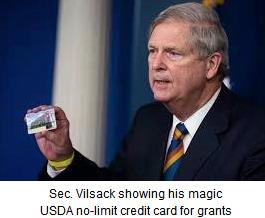The USDA has approved 71 grants under the Climate-Smart Commodities Program. This tranche follows a previous $2.8 billion for 70 projects mostly directed to universities and large-scale agricultural operations.
 The recipients in this series include “underserved farmers and ranchers from socially disadvantaged communities, veterans and those with limited financial resources”. Projects funded from $250,000 to $4.9 million will include substantial amounts to promote urban farmers and minorities growing crops in five Deep-South states. A grant of $4.9 million will apparently assist small and socially disadvantaged farmers in southern California by evaluating no-till and cover-crop cultivation. Regenerative agriculture, the value of which is currently in question, is the subject of $7.9 million in grants to farmers in ten states and tribal lands to grow barley and to evaluate drought-resistant farming practices.
The recipients in this series include “underserved farmers and ranchers from socially disadvantaged communities, veterans and those with limited financial resources”. Projects funded from $250,000 to $4.9 million will include substantial amounts to promote urban farmers and minorities growing crops in five Deep-South states. A grant of $4.9 million will apparently assist small and socially disadvantaged farmers in southern California by evaluating no-till and cover-crop cultivation. Regenerative agriculture, the value of which is currently in question, is the subject of $7.9 million in grants to farmers in ten states and tribal lands to grow barley and to evaluate drought-resistant farming practices.
Secretary of Agriculture, Tom Vilsack, noted that there would be a “concerted effort to monitor what programs succeed and those that struggled so the efforts could be replicated elsewhere in the U.S. and other parts of the world.”
 It is considered impossible for any federal department, including the USDA, to monitor and record results from 71 projects, especially since the so-called evaluations will be conducted by unsophisticated farmers without knowledge of experimental design, collection of data and interpretation of results. This entire exercise appears to be a directed giveaway disguised as scientific agronomic experimentation with the anticipation of producing data that can improve crop productivity. The exercise exemplifies the Administration commitment to uplifting “socially disadvantaged and minority farmers” with a generous distribution of public funds.
It is considered impossible for any federal department, including the USDA, to monitor and record results from 71 projects, especially since the so-called evaluations will be conducted by unsophisticated farmers without knowledge of experimental design, collection of data and interpretation of results. This entire exercise appears to be a directed giveaway disguised as scientific agronomic experimentation with the anticipation of producing data that can improve crop productivity. The exercise exemplifies the Administration commitment to uplifting “socially disadvantaged and minority farmers” with a generous distribution of public funds.
Due to the projected duration of the intended “experiments”, those responsible for selecting the successful applicants and approving projects will have long since moved on to other endeavors when the time comes for a review of results. It is doubtful whether U.S. Agriculture will ever receive appropriate data and recommendations that can guide improvements to either improve productivity or reduce greenhouse emissions. Does Sec. Vilsack not appreciate the value of his own Agricultural Research service staffed by professionals or the contribution of faculty and extension personnel affiliated with Land Grant Institutions and traditionally Black Colleges and Universities?